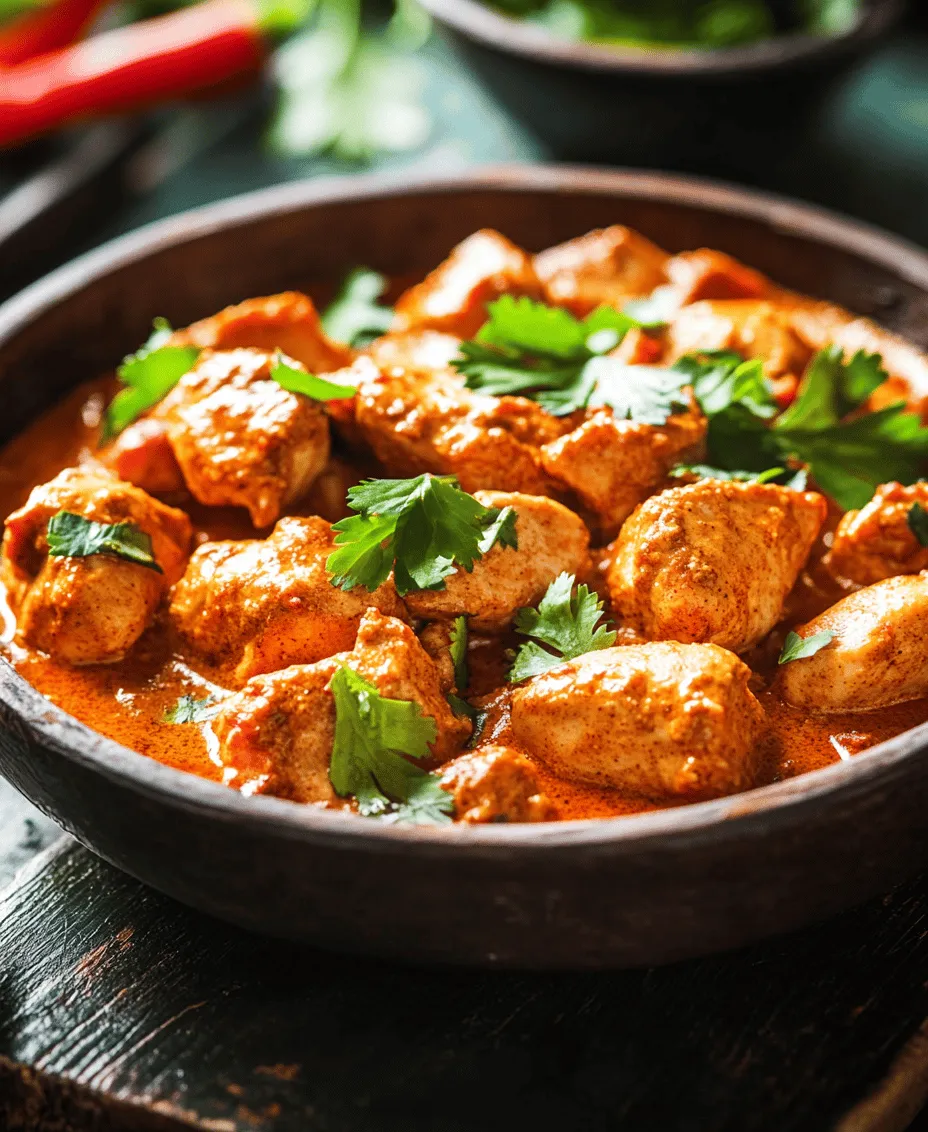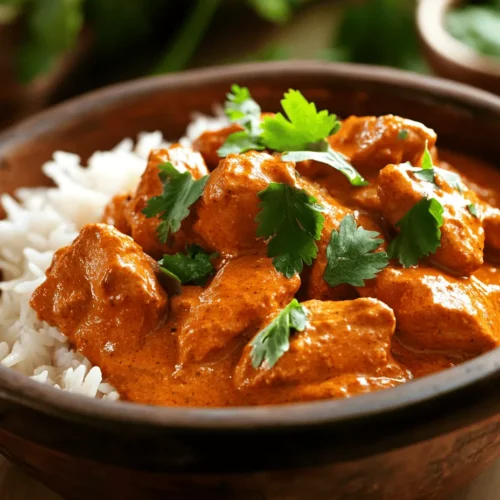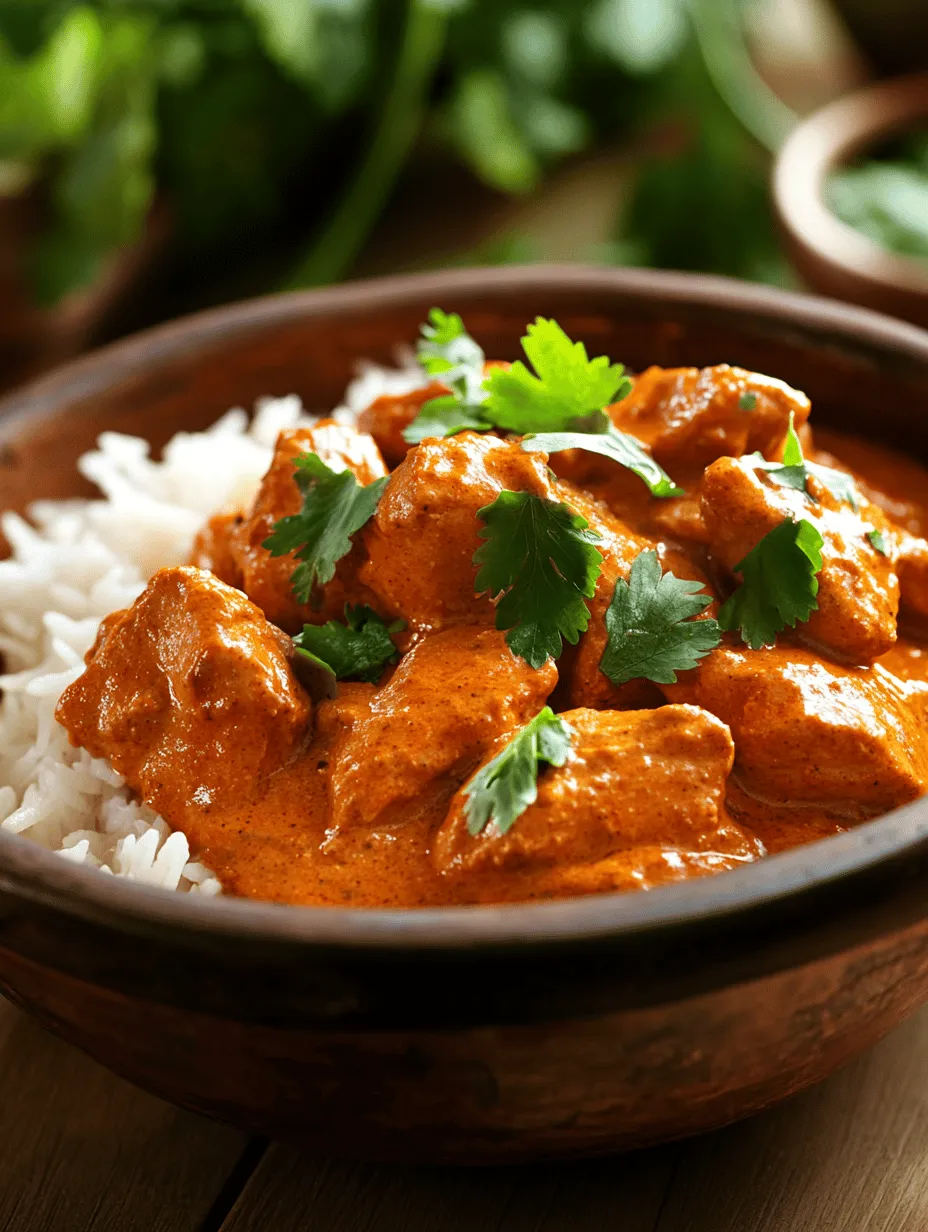Introduction
Explore the rich and aromatic world of Indian cuisine with Gordon Ramsay’s Chicken Tikka Masala, a beloved dish that has gained international fame for its flavorful complexity and comforting essence. This blog post will guide you through the steps of creating this culinary masterpiece at home, complete with detailed instructions and insightful tips to ensure your dish is nothing short of spectacular. With its marinated chicken, fragrant spices, and creamy sauce, Chicken Tikka Masala is not just a meal; it’s an experience that brings warmth and happiness to any table.
Chicken Tikka Masala has a unique ability to transport your taste buds to the vibrant streets of India, where the dish is celebrated for its robust flavors and inviting aroma. Often regarded as a British favorite, this dish has transcended cultural boundaries, making it a staple in restaurants around the world. The combination of succulent chicken marinated in a blend of spices, grilled to perfection, and then simmered in a luscious tomato cream sauce is what makes this dish a standout. If you’re looking to impress your family or friends with a homemade version of this classic dish, you’re in the right place.
Understanding the Essence of Chicken Tikka Masala
Origins of Chicken Tikka Masala
The exact origins of Chicken Tikka Masala are often debated, but it is widely believed to have roots in Indian cuisine, particularly from the Punjab region. Traditionally, Chicken Tikka consists of marinated chunks of chicken that are cooked in a tandoor, a clay oven that imparts a unique smoky flavor. The transformation into “Masala” occurs when the chicken is combined with a rich and creamy tomato-based sauce.
Interestingly, the dish gained significant popularity in the United Kingdom during the 1960s and 1970s, when South Asian communities began to flourish in the country. It is said that the dish was invented in a British restaurant by a Bangladeshi chef who improvised with leftover chicken and a can of tomato soup, ultimately creating the dish that would become a national favorite. Today, Chicken Tikka Masala is often viewed as a symbol of multiculturalism in British cuisine, representing a delightful fusion of flavors and cooking techniques.
Popularity in Western Cuisine and Cultural Adaptations
Chicken Tikka Masala’s journey from a traditional Indian dish to a beloved staple in Western cuisine highlights the adaptability and evolution of culinary practices. In the UK, it has become so popular that it was even dubbed “Britain’s national dish” by former Foreign Secretary Robin Cook in 2001. The dish has undergone various adaptations to suit local palates, with some variations incorporating different spices, levels of heat, and even alternative proteins.
In the United States and other parts of the world, Chicken Tikka Masala is often found on menus at Indian restaurants, but it has also inspired countless home cooks to recreate this dish in their kitchens. This universal appeal can be attributed to its rich flavors, comforting texture, and the sheer joy it brings to dining experiences. Whether served with rice, naan, or a side of vegetables, Chicken Tikka Masala has earned its place as a crowd-pleaser that can be enjoyed by all.
Ingredients Breakdown
To create Gordon Ramsay’s Chicken Tikka Masala, understanding the key ingredients is essential. Each component plays a crucial role in achieving the dish’s iconic flavor profile and texture.
Chicken Marinade Components
The first step in preparing Chicken Tikka Masala is marinating the chicken. The marinade typically consists of the following ingredients:
– Chicken: Boneless, skinless chicken thighs or breasts are commonly used. Thighs tend to retain moisture better, resulting in a more tender dish.
– Yogurt: This ingredient is a game-changer, as it not only adds creaminess but also serves as a tenderizing agent. The probiotics in yogurt break down the proteins in the chicken, making it more succulent.
– Lemon Juice: Freshly squeezed lemon juice adds acidity, which brightens the flavors and enhances the tenderness of the meat.
– Spices: The marinade is infused with a vibrant mix of spices, including garam masala, cumin, coriander, turmeric, and cayenne pepper. Each spice contributes its unique flavor, creating a well-rounded and aromatic profile.
The Role of Yogurt and Lemon Juice in Tenderizing Chicken
The combination of yogurt and lemon juice is vital in the marinating process. Yogurt contains lactic acid, which helps to break down the proteins in the chicken, resulting in a tender and juicy texture. The acidity of the lemon juice complements this process, adding brightness and a subtle tang that elevates the overall flavor. For the best results, allowing the chicken to marinate for at least one hour, or ideally overnight, ensures that the flavors penetrate deeply into the meat.
Understanding Spices: Garam Masala, Cumin, Coriander, Turmeric, and Cayenne Pepper
The heart of Chicken Tikka Masala lies in its spices. Understanding these ingredients will help you appreciate the complexity of flavors in the dish:
– Garam Masala: This quintessential Indian spice blend typically contains a mix of cardamom, cinnamon, cloves, and nutmeg, among others. It imparts warmth and depth to the dish.
– Cumin: Known for its earthy flavor, cumin adds a grounding element to the marinade.
– Coriander: With its citrusy undertones, coriander complements the other spices and adds freshness.
– Turmeric: This bright yellow spice not only gives the dish its characteristic color but also contributes a subtle bitterness.
– Cayenne Pepper: For those who enjoy a bit of heat, cayenne pepper adds a kick that can be adjusted according to personal preference.
The Curry Sauce Essentials
After the chicken is marinated and grilled, it is time to create the curry sauce, which is equally vital to the dish’s success. The key components of the curry sauce include:
– Onion: A finely chopped onion forms the base of the sauce. It is sautéed until golden brown, developing a rich, sweet flavor that enhances the overall dish.
– Garlic and Ginger: Freshly minced garlic and ginger are essential for building flavor. They add a fragrant, aromatic quality that elevates the sauce.
– Crushed Tomatoes: This ingredient provides the foundation of the sauce, adding acidity and sweetness. Using crushed tomatoes rather than tomato paste results in a more balanced flavor.
– Heavy Cream: To create a luscious, creamy texture, heavy cream is added to the sauce. It balances the acidity of the tomatoes and enriches the overall flavor.
– Additional Spices: The same spices used in the marinade can be incorporated into the sauce, ensuring harmony in flavor throughout the dish.
Importance of Onion, Garlic, and Ginger for Flavor Development
The trifecta of onion, garlic, and ginger is a staple in many cuisines, particularly in Indian cooking. When sautéed together, they create a deeply aromatic base that forms the backbone of the curry sauce. The caramelization of onions adds sweetness, while garlic and ginger contribute their distinctive flavors, resulting in a complex and satisfying sauce.
Analyzing the Impact of Heavy Cream and Crushed Tomatoes on Texture and Taste
The combination of heavy cream and crushed tomatoes transforms the sauce into a silky, rich concoction. The cream adds a luxurious mouthfeel, while the tomatoes provide acidity and a touch of sweetness. Striking the right balance between these two elements is key to achieving a well-rounded sauce that complements the marinated chicken beautifully.
Preparing the Chicken Marinade
Now that we have a comprehensive understanding of the ingredients involved in Gordon Ramsay’s Chicken Tikka Masala, it’s time to dive into the preparation of the chicken marinade. This step is crucial for developing the deep flavors that characterize this dish.
Step-by-Step Instructions for Marinating the Chicken
1. Choose Your Chicken: Start with boneless, skinless chicken thighs or breasts. Cut the chicken into bite-sized pieces to ensure even marination and cooking.
2. Create the Marinade: In a large mixing bowl, combine plain yogurt, freshly squeezed lemon juice, and the spice mixture (garam masala, cumin, coriander, turmeric, and cayenne pepper). Add salt to taste, which will help to enhance the flavors of the chicken.
3. Add the Chicken: Place the chicken pieces in the marinade, ensuring that each piece is thoroughly coated. The key to a successful marinade is even coverage, so use your hands or a spoon to mix everything well.
4. Marinate: Cover the bowl with plastic wrap and place it in the refrigerator. For optimal flavor, allow the chicken to marinate for at least one hour. If time permits, marinating overnight will yield even better results, allowing the flavors to penetrate the meat more deeply.
5. Preheat Your Grill or Oven: Before cooking, preheat your grill or oven to a high temperature (around 475°F or 245°C). The high heat is crucial for achieving that charred, smoky flavor reminiscent of traditional tandoor-cooked chicken.
6. Cook the Chicken: Once the grill or oven is hot, remove the chicken from the marinade, allowing any excess marinade to drip off. Place the chicken on the grill or a baking sheet lined with parchment paper. Cook for about 15-20 minutes, turning halfway through, until the chicken is cooked through and has a beautiful char.
By following these steps, you’ll ensure that your chicken is not only flavorful but also tender and juicy, setting the stage for an incredible Chicken Tikka Masala experience. With the chicken marinated and ready to go, you’re well on your way to creating a dish that will impress and delight all who gather around your table.

Cooking the Chicken
To create an authentic Chicken Tikka Masala, the method of cooking the chicken is crucial to achieving that tender, juicy texture while infusing it with flavors. The two most popular methods are roasting in the oven and grilling. Here, we’ll evaluate the pros and cons of each method.
Roasting in the Oven
Roasting is an excellent method for cooking chicken when you want to ensure even cooking and a tender result. When using the oven, preheat it to a high temperature (around 400°F or 200°C) to create a good amount of heat for roasting. Place the marinated chicken pieces on a baking tray lined with parchment paper for easy cleanup. One of the advantages of roasting is that it allows the chicken to cook evenly without the need for constant monitoring. However, it may not deliver the same depth of flavor as grilling, particularly the char that is characteristic of traditional Chicken Tikka.
Grilling
Grilling is the preferred method for many chefs, including Gordon Ramsay, as it imparts a smoky flavor and achieves a desirable char. If you have a barbecue grill or a grill pan, this method can elevate your dish significantly. Preheat the grill to medium-high heat, and lightly oil the grates to prevent sticking. The high heat from the grill will sear the chicken quickly, locking in juices while creating a caramelized exterior. The downside is that grilling requires more attention—flipping the chicken pieces regularly to ensure they don’t burn, while also ensuring the inside is cooked through.
Achieving the Ideal Char for Authenticity
Regardless of the method chosen, achieving the perfect char is vital. If grilling, avoid overcrowding the grill to ensure each piece gets adequate airflow. If roasting, you can switch to the broiler for the last few minutes of cooking to get that charred effect. Look for a deep golden color on the chicken, which indicates that it has developed a rich flavor profile.
Crafting the Curry Sauce
The heart of Chicken Tikka Masala lies in its curry sauce, which is rich, creamy, and deeply flavorful. Here’s how to craft a sauce that complements your perfectly cooked chicken.
Sautéing Onions
Begin by heating oil or ghee in a large saucepan over medium heat. Add finely chopped onions and sauté them until they reach a perfect golden brown color. This should take about 8-10 minutes. The caramelization of the onions adds a natural sweetness to the sauce, creating a balanced flavor base. Stir frequently, scraping the bottom of the pan to release any browned bits, which contribute to the overall flavor.
Balancing Spices
Once the onions are golden, it’s time to layer in the spices that define Chicken Tikka Masala. Common spices include cumin, coriander, turmeric, garam masala, and chili powder. Add these spices to the pan, stirring them into the onion mixture for about 1 minute until fragrant. This technique, known as blooming spices, allows the essential oils to release, enriching the sauce with aromatic flavors. Be careful not to burn the spices, as this can impart a bitter taste to your sauce.
The Simmering Process
Next, incorporate diced tomatoes (fresh or canned) and stir well to combine. Allow the mixture to simmer for about 15-20 minutes, enabling the tomatoes to break down and the flavors to meld. After simmering, add in the cream or yogurt, stirring to create a luscious consistency. If the sauce appears too thick, you can adjust the consistency by adding a bit of water or chicken stock. Allow the sauce to simmer for an additional 5-10 minutes, ensuring it thickens while developing a deep, rich flavor.
Combining Chicken and Sauce
Integrating the roasted chicken into your sauce is the final step to creating an unforgettable Chicken Tikka Masala.
Ensuring Even Coating of Chicken Pieces
Once your chicken is roasted, remove it from the oven and let it rest for a few minutes. Then, chop the chicken into bite-sized pieces, ensuring a uniform size for even distribution in the sauce. Add the chicken to the simmering curry sauce, making sure each piece is thoroughly coated. Use a wooden spoon to gently stir the chicken into the sauce, allowing the flavors to mingle.
Simmering to Meld Flavors
Allow the chicken to simmer in the sauce for about 10-15 minutes. This step is crucial—simmering not only warms the chicken through but also allows it to absorb the rich flavors of the sauce, creating a cohesive dish. Test the seasoning as you simmer; a pinch of salt or a squeeze of lemon juice can enhance the overall flavor profile.
Serving Suggestions
Presenting your Chicken Tikka Masala in an appealing way can elevate the dining experience. Here are some serving suggestions to consider.
Pairing with Basmati Rice
Basmati rice is the traditional accompaniment to Chicken Tikka Masala. To cook perfect basmati rice, rinse the rice under cold water until the water runs clear to remove excess starch, which prevents clumping. Soak the rice in water for about 30 minutes before cooking. In a pot, use a ratio of 1 cup of rice to 1.5 cups of water. Bring to a boil, then reduce the heat to low, cover, and cook for about 15-20 minutes until the water is absorbed. Fluff the rice with a fork before serving to create a light, airy texture that complements the rich curry.
Naan Bread Options
Naan is another classic side that pairs beautifully with Chicken Tikka Masala. You can opt for store-bought naan for convenience or try making your own for a more authentic touch. If you choose to make homemade naan, a simple dough made from flour, yogurt, and yeast can be rolled out and cooked on a hot skillet for a few minutes on each side. Brush with garlic butter or herbs for added flavor. Warm naan allows diners to scoop up the curry, enhancing the overall experience.
Conclusion
Gordon Ramsay’s Chicken Tikka Masala is a delightful representation of Indian cuisine, celebrated for its rich flavors and comforting nature. Whether you are hosting a dinner party or enjoying a quiet family meal, this recipe is sure to impress and satisfy. By understanding the ingredients, mastering the cooking techniques, and following the detailed instructions provided, you can create an authentic Chicken Tikka Masala that rivals your favorite restaurant.
Immerse yourself in the process and enjoy the journey of bringing this classic dish to life in your own kitchen. The combination of marinated chicken, aromatic spices, and a creamy sauce creates an experience that is both delicious and fulfilling. So gather your ingredients, embrace the cooking techniques discussed, and prepare to delight your taste buds with every bite of this flavorful classic.



